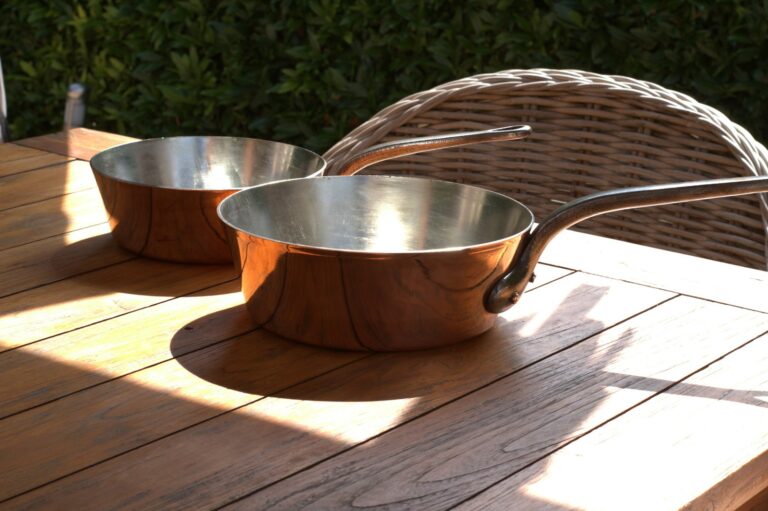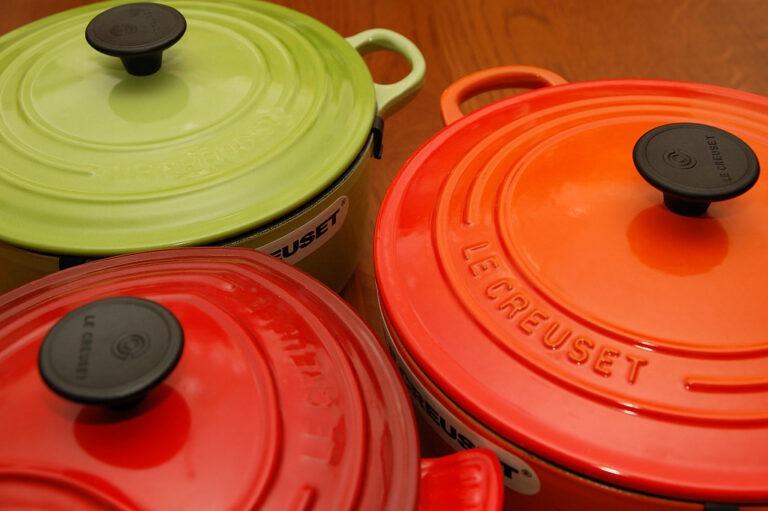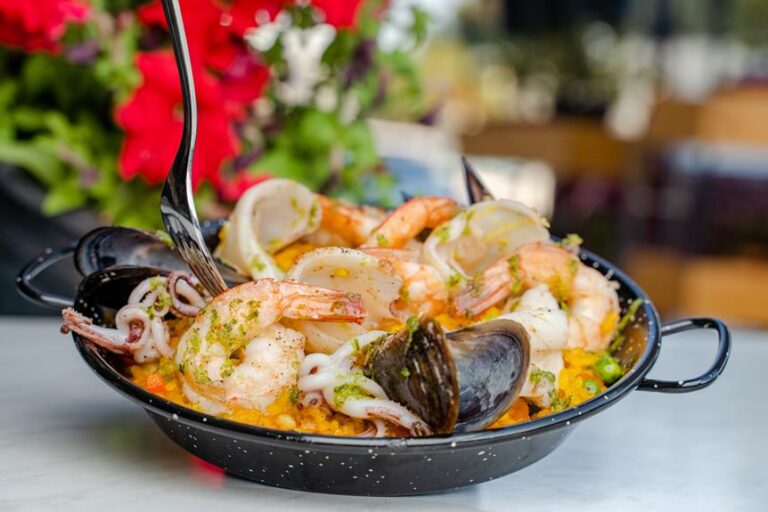I’ve always wondered if cast iron pans are coated or not. In this article, we’ll explore the different types of coating on cast iron pans and discuss the pros and cons of using coated ones.
I’ll also share some tips on how to identify a coated cast iron pan and the common materials used for coating.
Plus, we’ll answer important questions like how coating affects heat distribution and if coated pans can withstand high temperatures.
So let’s dive in and discover if coated cast iron pans are worth it!
Key Takeaways
- Cast iron pans can be coated with seasoning or enamel to enhance performance, create a non-stick surface, and add flavor to food.
- Coated cast iron pans require less maintenance, are easier to clean, and help prevent rusting.
- However, the coating may wear off over time and has limited heat resistance, making coated pans unsuitable for high-heat cooking.
- Coated cast iron pans have a smooth, non-stick surface, reduce the need for excessive oil or butter when cooking, and are more resistant to rust compared to uncoated pans.
Types of Coating on Cast Iron Pans
Yes, they are. Cast iron pans can be coated with various types of coatings to enhance their performance and prevent rusting. One common type of coating is a layer of seasoning, which is created by applying oil or fat to the pan’s surface and heating it at high temperatures. This seasoning creates a natural non-stick surface and adds flavor to the food being cooked.
Another popular coating option is enamel, where a layer of porcelain or ceramic is applied over the cast iron surface. This coating provides a smooth and colorful finish while protecting the pan from rusting. Additionally, some manufacturers also offer pre-seasoned pans that come with a factory-applied layer of seasoning for convenience.
Overall, these different coatings offer versatility and protection to cast iron pans, making them more durable and efficient in the kitchen.
Pros and Cons of Coated Cast Iron Pans
One of the advantages of using coated cast iron pans is that they require less maintenance. The coating on the surface prevents food from sticking, so all I need to do is give it a quick wipe with a sponge or cloth. No more scrubbing and soaking for hours just to remove stubborn residue!
Another benefit is that the coating helps prevent rusting. With traditional cast iron pans, I always had to make sure they were properly seasoned and dried after each use to avoid rust spots. But with the coated ones, I can worry less about rust and focus more on enjoying my delicious meals.
How to Identify a Coated Cast Iron Pan
To identify a coated cast iron pan, you can simply look for a smooth and non-stick surface that requires less maintenance. Coated pans have a layer of protective coating applied to the cast iron surface, which enhances their non-stick properties and makes them easier to clean. This coating also prevents food from sticking and reduces the need for excessive oil or butter when cooking. In addition, coated cast iron pans are more resistant to rust and require less seasoning compared to traditional uncoated pans. The table below compares the pros and cons of using a coated cast iron pan.
| Pros | Cons |
|---|---|
| Non-stick surface | Coating may wear off over time |
| Easier cleaning | Limited heat resistance |
| Reduced need for seasoning | Not suitable for high-heat cooking |
Overall, identifying a coated cast iron pan is as simple as looking for its smooth, non-stick surface. With less maintenance required, it offers convenience without compromising on performance in the kitchen.
Common Coating Materials for Cast Iron Pans
When it comes to coating options for cast iron pans, there are a few choices to consider.
One popular option is non-stick coating, which provides easy food release and requires less oil for cooking.
Another option is enamel coating, which offers benefits such as even heat distribution and resistance to rust.
Non-Stick Coating Options
There’s a variety of non-stick coating options available for cast iron pans. One popular option is seasoning the pan with oil or fat, which creates a natural non-stick surface over time. This method requires regular maintenance, but it can provide excellent results.
Another option is using ceramic coatings, which are known for their durability and non-toxic properties. These coatings are applied to the pan’s surface and offer a smooth and easy-to-clean cooking experience.
Additionally, there are also enamel coatings available for cast iron pans. Enamel is a type of glass that provides a non-stick surface while adding color and style to the pan.
It’s important to consider personal preferences and cooking needs when choosing a non-stick coating for cast iron pans.
Benefits of Enamel Coating
When it comes to cast iron pans, there are various coating options available. As mentioned earlier, non-stick coatings like Teflon can be used to make cooking and cleaning easier. However, another popular type of coating for cast iron pans is enamel. Enamel coating offers a range of benefits that make it a preferred choice for many home cooks.
One major advantage of enamel coating is its durability. It provides a protective layer that helps prevent rust and corrosion on the cast iron surface. Additionally, enamel-coated pans are also resistant to staining and scratching, making them more long-lasting compared to uncoated ones.
Moreover, the smooth and glossy finish of enamel coating creates a non-reactive surface that doesn’t interact with acidic or alkaline foods. This ensures that your dishes retain their original flavors without any metallic taste.
In summary, while non-stick coatings offer convenience, enamel coatings provide durability and versatility while preserving the natural flavors of your food.
| Benefits of Enamel Coating |
|---|
| Durability |
| Rust & Corrosion Resistance |
| Stain & Scratch Resistance |
| Non-Reactive Surface |
| Preserves Food Flavors |
Natural Seasoning Vs. Coating
Enamel coating provides durability and a non-reactive surface. It adds a protective layer to the pan, making it resistant to scratches and rust. It also prevents any reaction between acidic foods and the iron surface.
Natural seasoning, on the other hand, enhances the flavors of food. It involves building up layers of oil on the pan’s surface through regular use and proper maintenance. This creates a naturally non-stick surface that improves over time.
When it comes to cast iron pans, there is an ongoing debate between using enamel coating or relying on natural seasoning. Personally, I believe that both methods have their own advantages.
Ultimately, whether you choose enamel coating or natural seasoning depends on your preferences and cooking style.
Does Coating Affect Heat Distribution in Cast Iron Pans
When it comes to cast iron pans, the coating can have a significant impact on heat distribution.
Non-coated cast iron pans tend to distribute heat more evenly throughout the surface, while coated cast iron pans may have hot spots due to uneven heat distribution.
This difference in heat distribution can ultimately affect the cooking performance and results when using these types of pans.
Coating and Heat Distribution
To ensure even heat distribution, you’ll want to make sure that the coating on your cast iron pan is intact. The coating plays a crucial role in how the heat is distributed across the surface of the pan. When the coating is damaged or worn out, hot spots can occur, leading to uneven cooking. A well-maintained and properly seasoned cast iron pan with a good coating will provide consistent heat distribution and prevent any areas from getting too hot or too cold.
Here’s a comparison between coated and uncoated cast iron pans:
| Coated Cast Iron Pan | Uncoated Cast Iron Pan |
|---|---|
| Even heat distribution | Uneven heat distribution |
| Non-stick surface | Requires seasoning for non-stick abilities |
| Easier to clean | Requires more maintenance |
Non-Coated Vs Coated
Having a non-coated cast iron pan requires more maintenance compared to a coated one. I learned this the hard way when I first started using my cast iron pan without any coating. Without the protective layer, food tends to stick more easily, making it harder to clean.
Every time I use my non-coated pan, I have to make sure to season it properly beforehand and clean it thoroughly afterwards. This can be time-consuming and requires extra effort compared to using a coated cast iron pan.
With a coated pan, the non-stick surface makes cooking and cleaning much easier. It’s definitely worth considering investing in a coated cast iron pan if you want less hassle in your cooking routine.
Impact on Cooking Performance
The non-stick surface of a coated cast iron pan greatly improves cooking performance. When I use my coated cast iron pan, I notice that food doesn’t stick to the surface as much compared to when I use a non-coated pan. This means that I can cook delicate foods like eggs or fish without worrying about them getting stuck and ruining the dish.
The coating also helps distribute heat more evenly across the surface, resulting in better cooking results. I find that my food cooks quicker and more uniformly in a coated cast iron pan compared to a non-coated one.
Additionally, the coating makes cleaning up a breeze since food particles don’t cling stubbornly to the surface. Overall, using a coated cast iron pan has significantly improved my cooking experience.
Maintaining the Coating on Cast Iron Pans
Maintaining the coating on cast iron pans can be easily done with regular seasoning. I find this method to be effective in keeping my pans in great condition and ensuring optimal cooking performance.
Here are some key steps to follow for proper maintenance:
- Clean the pan thoroughly after each use, using hot water and a stiff brush.
- Dry the pan completely to prevent rusting.
- Apply a thin layer of oil or fat to the entire surface of the pan.
- Heat the pan on low heat until it starts smoking, then remove it from the heat and let it cool.
- Repeat this process regularly to build up a strong coating that will protect your cast iron pan.
Can Coated Cast Iron Pans Withstand High Temperatures
When it comes to cooking at high temperatures, the durability of coatings becomes crucial. I have always wondered about the heat resistance of coatings and whether they can withstand the intense heat in my kitchen.
In this discussion, we will explore the key points of coating durability at high temperatures and delve into the heat resistance of different types of coatings.
Coating Durability at High Temperatures
If you’re using a cast iron pan at high temperatures, make sure the coating is durable enough to withstand the heat. I learned this the hard way when my old cast iron pan started to peel and chip after being exposed to high temperatures.
To prevent this from happening again, here are a few things to consider when choosing a cast iron pan coating:
- Type of Coating: Look for coatings made specifically for high heat cooking, such as porcelain enamel or seasoned oil.
- Thickness: Thicker coatings tend to be more durable and can better withstand high temperatures.
- Heat Resistance: Check if the coating has been tested and certified to handle the desired temperature range.
- Maintenance: Some coatings require special care and maintenance, so make sure you are willing to put in the effort.
- Manufacturer’s Recommendations: Always follow the manufacturer’s instructions on maximum heat limits and proper usage.
Heat Resistance of Coatings?
The heat resistance of coatings is an important factor to consider when choosing a cast iron pan. As someone who loves cooking, I want to make sure that my pans can withstand high temperatures without the coating deteriorating or releasing harmful chemicals. To help you understand the heat resistance of different coatings, I have created a table below:
| Coating Type | Maximum Temperature (°F) | Advantages |
|---|---|---|
| Seasoned | 500 | Natural non-stick surface |
| Enamel | 450 | Easy to clean and maintain |
| Ceramic | 600 | Scratch-resistant and durable |
This table provides a visual representation of the maximum temperature each coating type can handle and their respective advantages. It is essential to choose a coating that suits your cooking needs and preferences.
Coated Vs. Uncoated Cast Iron Pans: Which Is Better
You should consider which type of cast iron pan is better for you: coated or uncoated. Personally, I prefer the coated cast iron pans because they offer several advantages over their uncoated counterparts.
- Non-stick surface: The coating on these pans prevents food from sticking, making them easier to clean.
- Versatility: Coated cast iron pans can handle a variety of cooking methods, including frying, sautéing, and baking.
- Durability: The coating helps protect the pan from rusting and extends its lifespan.
- Even heat distribution: The coating ensures that heat is evenly distributed across the cooking surface, reducing hot spots.
- Less seasoning required: Unlike uncoated cast iron pans that require regular seasoning to maintain their non-stick properties, coated pans often come pre-seasoned or require minimal maintenance.
Considering these benefits, a coated cast iron pan might be the better choice for those looking for convenience and versatility in their cooking experience.
Are Coated Cast Iron Pans Safe to Use
When it comes to cast iron pans, one question that often arises is whether coated ones are safe to use. Well, I can assure you that they are!
Coated cast iron pans have a layer of enamel or other non-stick material on the cooking surface. This coating prevents food from sticking and makes cleaning easier.
Not only do these coatings provide convenience, but they also act as a protective barrier between the food and the iron, reducing the risk of iron leaching into your meals.
How to Choose the Right Coating for Your Cast Iron Pan
If you’re unsure which coating to choose for your cast iron pan, consider researching different options and their benefits. It’s important to find the right coating that suits your cooking needs and preferences. Here are some factors to consider:
- Seasoned: A classic option, seasoning creates a natural non-stick surface by building up layers of oil.
- Enamel: Provides a smooth and colorful coating that is resistant to staining and rusting.
- Ceramic: Offers excellent heat retention and distribution while being non-reactive with acidic foods.
- Oil-based: These coatings provide a protective layer against rust and help maintain the pan’s seasoning.
- Pre-seasoned: Some cast iron pans come pre-seasoned, which saves time and effort in getting them ready for use.
Conclusion
In conclusion, coated cast iron pans are a great option for those who want the benefits of cast iron cooking with added convenience. They come in various coating materials that offer different advantages and disadvantages.
While coated pans may affect heat distribution to some extent, they can still withstand high temperatures and provide excellent cooking results. Ultimately, whether to choose a coated or uncoated cast iron pan depends on personal preference and cooking needs.
With proper care, coated cast iron pans can be safe to use and provide years of delicious meals.




